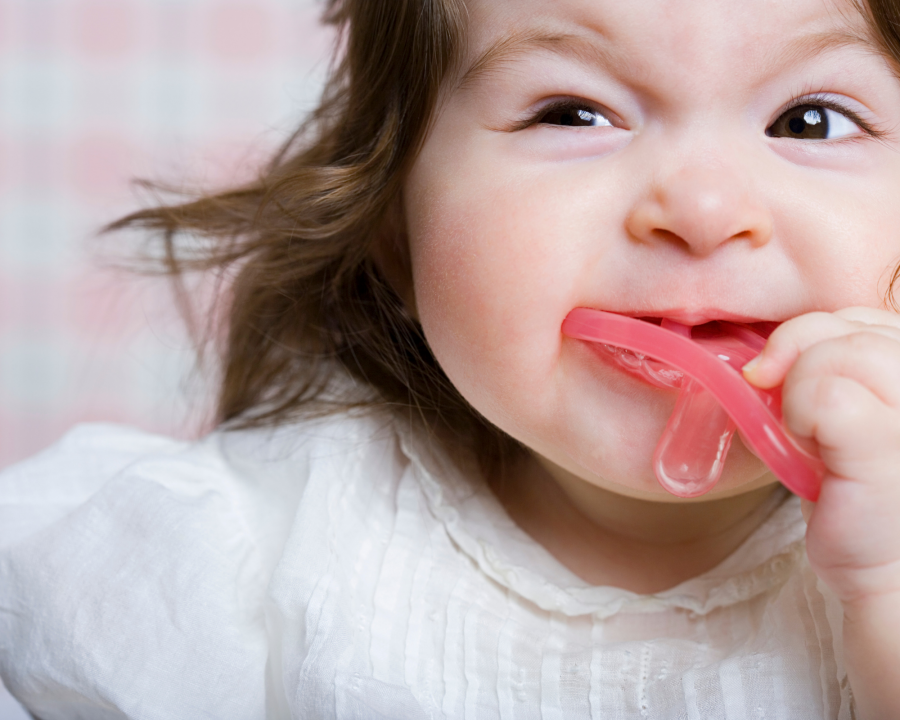My opinion of pacifiers developed before I even had children of my own. I remember telling my husband that I’d never let my child have a pacifier during the day once he or she could talk. Fast forward 15 years and I am staring at my own six-year-old still sucking her thumb! Having a thumb sucker has meant my daughter has a built in self-soothing tool. She never cried for me to replace her pacifier in the night, because her thumb was always right there. But, it is much easier to get rid of a pacifier than it is to end the thumb-sucking habit. You can’t box up a thumb and send it to the pacifier fairy!
Current Recommendations on Pacifier Use
The attitude towards pacifiers has changed over the past 5 years due to their inclusion in the American Academy of Pediatricians’ recommendations for safe sleep to reduce the risk of sudden infant death syndrome (SIDS) or accidental deaths from suffocation or strangulation.
Pacifier Use and Breastfeeding
The AAP statement clearly says that pacifier use should be initiated once breastfeeding has been established, recommending waiting two to three weeks after birth.
However, the research is conflicting on whether pacifier use early in the newborn period impacts breastfeeding negatively. Some research even suggests that limited access to pacifiers in the initial postpartum period may actually increase the use of formula.
A review of the literature done in 2016 and published in a Cochrane Review shows that the use of pacifiers in the early postpartum period doesn’t appear to have an impact on exclusive breastfeeding. However, there is limited research on the short or long term impact on other factors, like breastfeeding difficulties, infant crying, and infant health. In fact, one study showed that long term pacifier use is associated with a lower IQ, but the casual relationship and mechanism behind this is unclear.
Pacifier Use and Sleep
Many parents worry about how a pacifier may impact sleep. Contrary to what I’ve experienced in my practice, some research suggests that sleep is not negatively impacted by the use of pacifiers. I have worked with enough families who are constantly playing the pacifier pop-in game to confidently say that in the real world, the use of pacifiers can absolutely become a sleep crutch. The research does support my experience that babies who suck their thumb or fingers have less sleep difficulties. That thumb is always there—day or night!
Protecting Your Baby From Becoming a Paci Addict
You can benefit from the protective factor of pacifier use and still protect your baby from becoming a pacifier addict:
Practice sleep without a pacifier: If your baby spits out the pacifier while sleeping, leave it out. You can also try putting your baby down without a pacifier once in the while. This will allow your baby to become comfortable sleeping with it, and without it. Your baby may also find his thumb or fingers and prefer that built-in soother.
Help him learn to replace it on his own: Once your baby is 8 months old, do not run in and replace the pacifier, even if your baby wakes and cries for it. Sit back with curiosity and see if he can find it on his own. Most babies have the gross motor skills to find and replace their pacifier without help by this age. You can even sprinkle a few pacifiers around the crib so that it is easier for your baby to find one.
Don’t use pacifiers to replace feedings: It is true that sometimes babies need to suck for comfort and not nutrition, but suckling at the breast plays an important role in establishing your supply in the early months. Learn your baby’s hunger cues and do not use the pacifier to try to hold off or spread out feedings. But if your baby is fed and wants to suckle often, using a pacifier may give you a short break, especially if your baby is high needs.
Drop the pacifier before age 2: Most babies will drop the use of their pacifier on their own between two and three years of age. But many will need a little help. The drive to sleep during the day gets weaker as your child gets older. The longer you wait to take away the pacifier, the greater the risk of it impacting naps. The need for day sleep in a baby under 2 years old is still high. Taking away the pacifier might impact naps for a week or so, but eventually biology takes over, your baby learns a new sleep association, and the nap returns to normal. But if you take a pacifier away from a preschooler whose drive to sleep during the day is weak, his naps may be lost for good before he learns a new sleep association. Don’t risk it. Plan to end pacifier use before your baby becomes a toddler.
Don’t allow the pacifier to become a game: Toddlers learn quickly that if they throw their pacifiers out of the crib, parents will come running to replace it. This can become a game for stalling bedtime and getting your attention in the middle of the night. You’ll need to consistently set limits so that your toddler learns that if he wants his pacifier for sleeping, he shouldn’t throw it out of the crib. And as hard as it is to set limits consistently in the middle of the night when you are exhausted, the consistent really does matter most. If you replace the pacifier inconsistently, it will fuel the behavior even more because of the impact of inconsistent reinforcement.
Need help coming up with a plan to set limits with empathy, respect, and resolve? Sign up for one of our consults to get the support you need to be successful.

